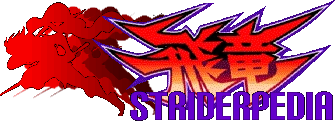Strider started life as part of a three-pronged collaboration between Capcom and artist circle Moto Kikaku, consisting of this game, the Strider Hiryu manga, and a game for the NES, all sharing the same name.[1]
The idea of working on a project with a company outside the world of gaming came from Akio Sakai, who back then recently joined Capcom as new head of development[2][3][4]. Sakai was able to secure the deal with Moto Kikaku, seeing it as a test to running a seralized manga and game at the same time.[2]
Development for the Arcade game befell Capcom's "First Planning Room", one of the three development division at the time, head by Tokuro Fujiwara[5]. After initial meetings, the core group for the project was quickly decided. Tatsumi Wada from Motomiya Kikaku was put in charge of the manga; the "consumer version" was given to Masahiko Kurokawa; and Tokuro Fujiwara handed the coin-op over to the background artist from Ghouls 'n Ghosts and Bionic Commando, Kouichi Yotsui, choosing him partly due to his experience with the CPS-1 Arcade board[4] and because Fujiwara felt Yotsui had "really good negotiation skills."[3]
Development History
Collaboration
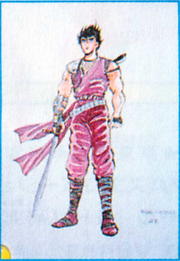
Early concept art of Hiryu
In order to iron out the project's setting and world view the CEO of Capcom, Kenzou Tsujimoto, paid for the three men to stay at the Shinjuku Hilton hotel, along with a fourth, unnamed marketing executive from Capcom[2]. The three project leads laid out the outline of the story as if it were a manga and focused primarily on the main character; at first difficult, once they settled on a ninja protagonist, the way he would move and the kind of game that'd suit such a character came easily[4]. Because they were developing an action game, Yotsui pushed hard for a futuristic ninja concept, drawing equal inspiration from both the Shinjuku skyline outside their hotel windows and ninja TV series from the 1960's. At one point, he found himself locked onto a building's rooftop. He climbed down the side of the building to the fire escape, "desperately afraid" that he would "die from the fall", though he also couldn't stop thinking about the game, concluding that "anybody that wanted to do that kind of thing must be crazy."[3]
During the course of a week, they worked out all three projects' common thread: the year 2048, Kazakh as the initial location, and Hiryu as the main hero[2][3]. Afterward, Wada returned to Motomiya Kikaku. Yotsui and Kurokawa returned to Capcom's headquarters in Osaka, working together to flesh out the rough outline all had agreed upon in Shinjuku[2]. The trio took advantage of Yotsui and Kurokawa's background in film as well: having both went to the same university and graduated in film, they were into "plots and stories" and were able to write out a scenario, coming up with several ideas for settings and creating all sort of details[3][4]. Yotsui, however, decided to only utilize the details that would "convey the atmosphere" he wanted players to feel, while leaving the rest to their imagination.[4]
They created Hiryu's design and sent it to Motomiya Kikaku in Chiba along with a few draft chapters[2]. Yotsui and Kurokawa ended up writing a personal script each for the project[6][7], with the finalized script adapted by Moto Kikaku's hired scenario writer[7], Tetsuo Shiba, serving as the basis for the manga's story. Even though the basic idea was in place, Yotsui and Kurokawa still travelled constantly between the Capcom and Moto Kikaku offices, meeting with Wada and discussing new ideas over dinner. Although the three not always agreed on their opinions, their continued exchange allowed them to build the world of Strider more effectively.[3]
Isuke's Strider

Kouichi Yotsui, circa 1988
Each team was supposed to take this fully-formed idea and adapt it to their assigned media[1]. Despite this initial intent, however, Kurokawa and Wada's ideas wound up overlapping considerably. They developed an involved storyline that became the backbone of both the manga and the consumer version being produced for the Famicom[2]. They wanted Yotsui to follow their ideas, but Yotsui viewed it as a competition to see who could make the best game[1]. In particular, Yotsui wanted to take Ghosts 'n Goblins gameplay "to the next level", wondering how far he could take an action game "with one lever and two buttons". He felt it would be "impossible" to tell a complex story in an arcade game, as it would "destroy the gameplay"[2]. He wanted to make "an adventure that stimulates the senses", and imagined the player "running, running, running to freedom". He believed that this type of game would best suit the coin-operated arcade format, not a plot-intensive storyline.[2]
Yotsui also felt that each project should heighten the Strider world through the methods each platform excelled at. Though he wanted to represent the same enjoyment provided by the manga's story, he considered trying to tell the story literally would compare his game unfavorably with his project brethren; so he instead decided to use the Arcade's raw power to describe the action through visual imagery, thinking that would "turn the table" on his favor[3]. Thus, the coin-op strayed somewhat from the original outline and built its own story.

Hiryu's in-game sprite
Strider started development as the third game in Capcom's then-new CP System arcade board, alongside Ghosts n' Ghouls and Forgotten Worlds[2]. Before that, Capcom's Arcade games were done on custom hardware tailored to the project's needs, thus resulting in underpowered boards that were just enough to run character sprites at 16x16 pixels. The CP System allowed Isuke and his team to create characters at twice that size (32x32 pixels), making them "seem very large" in comparison[4], a fact which was often praised about the game. Initially Hiryu's sprite was even bigger, but since the other artists made enemy sprites smaller, Hiryu had to be adjusted so as to not stand out too much.[8]</ref>
While creating the game, Yotsui tried to design it in such a way as to appeal to Arcade gamers and "extract their money", noting that the onscreen action had to impress not only the player, but also the ones standing behind them, watching them play[4]. To achieve this, Yotsui felt he needed to show a new location with each stage and a constant stream of new ideas. Hiryu's agility and mobility were vital to Yotsui as well, considering it the most important thing to have players be entertained and to enjoy the simple act of controlling Hiryu.[9]
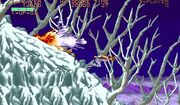
Stage 2's "mountain run" is often cited as one of the game's most memorable moments.
He considered the second stage specially important, because it showed that the game would be constantly changing and this would incite players to see what'd come next. He also sought to subvert player's expectations, for instance by having a huge boss at the beginning of the stage instead of at the end.[4]
Despite its initial development plan of eight months, Strider suffered from several delays due to Isuke demanding perfection from his staff[3][4], with internal rumors that these delays would inversely affect sales[1]. In spite of this and Isuke's young age, he was shown a surprisingly amount of leniency from Fujiwara, giving him free rein and ensuring that Strider would "only be finished once [Isuke] said so"[3]. The results, however, always felt short of what he envisioned. Isuke felt frustrated most of the time because he wanted to do much better, but the technology at hand wasn't able to keep up with his ambitions.[4]
Strider was initially scheduled to release in December 1988[10][11], but Isuke's filmic tendencies and drive for perfection caused the game to overshoot its budget and miss the date, eventually being released in March 1989 instead.[4]
Promotion
Strider was first revealed to the public during the 1988 Tokyo JAMMA AM Show held in September. Both Japanese[12] and Western magazines covered the game at the event, the latter under the initial localized title of "Falcon"[13][14]. The event formally introduced the initial 2 stages and the Amazon stage, here listed as the 3rd stage. Although early reports stated the game would feature a stage selection system for the 3rd and 4th stage[10], this was seemingly dropped by the time of this presentation[12]. Notably, the batch of screenshots released at the time, based on an earlier build of the game, would be reused years after in previews of the PC Engine port.
Strider was first unveiled to the European audience during the London ATEI (Amusement Trades Exhibition International) event held at the beginning of 1989, now under its final title[15]. Yotsui also stated that he attended a location test held in California at one point, where he drew the final English logo.[2]
Following its delay, Strider was not seen in Japan until the February 1989 AOU Show, where the Flying Battleship Balrog was first introduced[16]. During the event, attendees were able to play the initial two stages in prototype Arcade cabinets set at the location.
Influences

R-Type's gameplay was one of Strider's influences
In creating the coin-op, Kouichi Yotsui drew inspiration from several sources. The multiple layers in Rolling Thunder suggested level design, and the helper characters in R-Type gave rise to the Option A's. Shirato Sanpei's Kamui Gaiden, whose ninja hero was accompanied by animal characters, suggested Option B and C[2]. Gameplay and level design, as well as Hiryu's agility and high acrobatics, were inspired not only from the roof incident described above, but also from Isuke's own love of mountain-climbing, skiing and diving.[3]
Characters
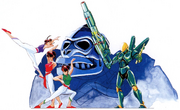
The bounty hunter Kuniang sisters and Solo, and the large boss Mecha Pon
The game features a cast of multi-cultural and unfamiliar characters and bosses that were designed by Isuke with the intention of surprising players, and they were also pivotal in expanding the world within the game[9]. A variety of sources inspired most of them: The minor foes were originally intended to wear clothes, but most of these ended up getting cut from the final product, the Rascal's fur hat being the only remain left in-game. Most side characters like Tong Pooh, Solo and Captain Beard Jr. were introduced because Yotsui wanted to "show characters that didn't have a direct relationship with Strider or the Grand Master", in much the same way the scene of Darth Vader's hiring bounty hunters in The Empire Strikes Back did. Yotsui felt this would "broaden the scope" of the game's world[2]. The large end-of-level bosses were inspired directly by Hiryu's nimble movements and climbing ability, feeling that "it made sense" having large enemies for the hero to face, and that enemies that took up half of the screen were perfect for an action game. Yotsui, however, felt they ended up being way too easy.[4]
Varied real-life sources were also used as inspiration: Tong Pooh was inspired by Bruce Lee and the "Kung Fu Boom" of the time and named after a song from side two of Yellow Magic Orchestra's eponymous album, Mecha Pon was an homage to Toho's Mechani-Kong; Grandmaster Meio was inspired by an image of Sauron, the Dark Lord of J.R.R. Tolkien's Lord of the Rings; and Lago was a bizarre pastiche containing the basic shape of a dinosaur, the clawing mannerisms of a chicken, and a head based off "the front of an F-16 fighter".[3]
World Setting
The use of a communist background was not influenced by the politics of the time, but simply because Isuke desired an unique setting that hasn't been in common use like America or Japan were. He describes his decision to use Russia and "Middle Eastern-style Mosques" as him being "immature" and "riding on the waves" of the [Cold War] times[2]. He also considered that part of the world "fresh" and "mysterious".[4]
To further enhance this feeling of a fully-formed world, Yotsui took the unusual step of reaching outside of his development team. Yotsui wanted "Strider to be able to run around an immense world that was filled with marvels", desiring "a really exotic mood", so he added short cinema scenes between stages to advance the story[3]. To voice the characters, Yotsui utilized the talents of a Capcom employee who had graduated from a "language academy" and a few of his friends. Their combined talents enabled the characters to speak in five different languages: Japanese for Hiryu, English for the Grandmaster and Solo, Mandarin Chinese for Tong Pooh, Russian for General Mikiel and Spanish for Captain Beard Jr. A sixth language, Swahili, was considered for the Amazon tribeswomen, but Capcom objected against it on the grounds that portraying someone as primitive looked like discrimination.[1]
Music
The original arcade game soundtrack was composed entirely by female video game music composer Junko Tamiya, who was not credited for her work in the arcade version but was mentioned as part of the original arcade staff and as the original composer in some console adaptations and game soundtrack compilations[17] released afterwards.
Strider contains many different styles of incidental music themes that change dynamically throughout the game according to the stages and the situations on screen. These range from experimental and progressive futuristic sci-fi action themes to baroque, tribal and classical music pieces. Elements from the soundtrack have also been used in other Capcom games where Hiryu has appeared. These include the Marvel vs. Capcom series as well as other Strider related games.
Early revisions of the arcade game were missing the unique music for the Aerial Battleship and Third Moon stages. In this version the music from the first stage of the game was repeated here instead.
Development
According to Tamiya herself, she relied on FM sound sources for producing each of the songs for the Strider Arcade soundtrack[18]. Tamiya was told by the game's planners and the main designer that due to the non-stop action of the title and the several colorful scenarios there would be an emphasis on emotions and feelings, so she composed the tracks with that in mind.[17][18]
Before starting to work, she was also given Yotsui's direct instruction to study Igor Stravinski's "The Rite of Spring"[3][17]. Isuke made her listen to the song over and over again while rejecting her initial works as he wanted the music to be perfect, and made a lot of demands to the sound staff, desiring the themes to be dramatic but also full of energy[3]. Tamiya couldn't stand hearing that song every day, describing it as being way too quiet and scary[17]. Eventually, however, she started to understand what Yotsui liked and didn't liked and made pieces he had no problems with.[3]
Afterwards, Tamiya was detailed about the game image that the planner was strongly pushing for. Creating music to complement that image took quite some time. That’s what led her to compose the unique main theme and the distinctive varied rhythms of each stage. Once this framework was established, Tamiya made the music as she liked and saw fit[18]. She recollects being specially excited to do a theme with African-like percussion instruments, being in a high mood when she composed it and enjoying its disjointed sequence.[17]
Isuke's stated inspiration for the music came from classic ballet and Walt Disney cartoons[3]. Tamiya's inspiration for the first song of the soundtrack ("Defense Line - Raid!") was actually Mike Oldfield's 1973 piece Tubular Bells.[18]
Localization
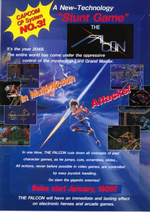
"The Falcon" poster
How to localize Strider was the source of some debate within Capcom. The overseas division was initially unhappy with the game's Japanese title, fearing it would confuse Western gamers. Yotsui came up with two alternate titles: Ninja Dynamics and Falcon, thinking that Hiryu's actions would remind the player of a bird of prey. "Falcon" showed up as the game's official English title during its reveal at the AM Show[13][14], and some posters with the Falcon logo were printed up and are still in existence[2]. By the beginning of 1989[15], however, this name change was seen as unnecessary, it was dropped, and the title was shortened to Strider instead.[2]
The final English release of Strider was practically unaltered from the Japanese original game, with the only notable change being the omission of a voice sample, a "Hah!" clip yelled by Hiryu every time the player attacks.
Ports
Home computers
- Main article: Strider (Home computers)
U.S. Gold published several ports for home computers exclusively in Europe, as part of a 12-title contract with Capcom USA. The company handed development duties over to Manchester-based Tiertex, which worked on six ports simultaneously for the Amiga, Atari ST, Commodore 64, ZX Spectrum, Amstrad CPC and PC-DOS. Capcom has almost no involvement over these conversions, only providing Tiertex with an Arcade machine for them to extract graphics and gameplay from. All the conversions were released in the latter half of 1989 to general positive reviews in spite of their many shortcomings.
Mega Drive/Genesis
- Main article: Strider (Mega Drive)
Officially announced in Japan in the middle of 1990, and shortly afterwards during the Winter CES convention in Las Vegas, Strider for the Mega Drive/Genesis was developed internally by Sega, as was customary of the company at the time. Initially reported as a 6 Mega cartridge game, it was instead released in September 1990 as the very first game on a 8 Mega cartridge. A very close adaptation of the Arcade original, it became a system seller.
This conversion was rereleased in 2011 for the Wii Virtual Console in all regions. It was also included in the English and Asian versions of the Mega Drive/Sega Genesis Mini retro console released in 2019, and in 2021 included in the au Smart Pass Premium Classic Games service for Android and iOS, as well as the Nintendo Switch Online Service as part of the "Sega Genesis/Mega Drive Expansion Pack".
PC Engine
- Main article: Strider (PC Engine)/Development
Infamous for its protracted development cycle, this port of Strider was first announced in August 1989 and soon after confirmed as an exclusive game for the short-lived SuperGrafx. The game's development was extended over four years, changing media 5 times until its final release in 1994 as a PC-Engine Super CD-ROM² game with Arcade Card support. The final product includes an exclusive extra stage, red-book quality audio and animated cutscenes.
Other ports
In 1992 Capcom released an almost perfect port of the Arcade game for the Sharp X68000, exclusively in Japan.
In 1994 Capcom released a home version of the CPS-1 Arcade board known as the CPS Changer, similar to SNK's Neo Geo console. Initially Strider was one of 24 CPS-1 titles previewed for the console[19], but was never released as the console would end up receiving only 11 titles (10 CPS-1 games plus a ported-down version of the CPS-II game Street Fighter Zero) before being shelved.
Strider was included as a bonus disc in the PlayStation port of Strider 2 with some additional content such as an Options setting and unlockable alternate palettes for Hiryu. Unlike the Strider 2 port, this port was outsourced to Japanese company "Use". This version was later re-issued alone in 2006 as part of the Capcom Gamebooks series, packaged with an extended manual/strategy guide.
The Strider 2 compilation was also included as a download code in Japanese PlayStation 3 copies of the 2014 Strider and later made available through PlayStation Network in both Japan and America, accessible for the PlayStation 3, PlayStation Vita and PlayStation Portable. The PlayStation Portable version will be unavailable following July 2, 2021 after the retirement of the console's digital store.[20]
Strider was released in 2010 for mobile devices through the Japan-only i-mode website "Capcom Party", a faithful adaptation with minor upgrades, most notably an online scoreboard. It became unavailable after the service and website were shut down in March 31, 2018.
Compilations
The original Arcade game was included as part of the compilations Capcom Classics Collection Remixed for the PlayStation Portable and Capcom Classics Collection Volume 2 for PlayStation 2 and Xbox, released in 2006. This version is an emulation of the Arcade ROM with the missing Stage 3 and 5 music.
In 2019, Capcom announced the Capcom Home Arcade, an Arcade stick plug & play with 16 pre-installed games from the company's Arcade CPS-1 and CPS-2 catalog, Strider among them[21]. The stick was released on November 8, 2019 in Europe.
Strider is also part of the line-up in Capcom's February 2021 digital compilation Capcom Arcade Stadium, released initially for the Nintendo Switch and for Xbox One, PlayStation 4 and PC at a later date. The compilation includes 32 games split in different bundles, with Strider being part of Pack 2 "Arcade Revolution". Unlike previous compilations, the more complete ROM set with the restored music score is used.
Other releases
In 2017, Strider was confirmed part of the lineup for Retro-Bit's Retro-Bit Generations 2, a retro game console which includes a total of 42 Arcade, 8 and 16-bit console game titles[22]. The console was released on October 28, 2017 exclusively on Japan[23]. Retro-Bit would also release a console for the English market known as the Super Retro-Cade in December 2017, which included among its roster of 90 licensed games not only the original Strider but the NES version as well.[24]
In 2018, Strider was announced as one of the games featured in Tastemaker's first wave of "Arcade1Up", a set of smaller-scale Arcade cabinets installed with a number of classic titles. Strider is featured as part of the Final Fight cabinet together with 1944: The Loop Master and Ghosts 'n Goblins.[25]
References
- ↑ 1.0 1.1 1.2 1.3 1.4 Tane, Kiyofume (February 2009). "The Father of Strider Who Made the Game World Explode: Kouichi Yotsui Discography". Gameside (16). Translated by Gaijin Punch for Gamengai. Retrieved from Archive.org. Accessed January 18, 2020.
- ↑ 2.00 2.01 2.02 2.03 2.04 2.05 2.06 2.07 2.08 2.09 2.10 2.11 2.12 2.13 2.14 2.15 Scion; Dire 51 (24 April 2010). "Interview with Kouichi "Isuke" Yotsui". LSCM 4.0. Translated by Gaijin Punch. Accessed 24 Oct 2010.
- ↑ 3.00 3.01 3.02 3.03 3.04 3.05 3.06 3.07 3.08 3.09 3.10 3.11 3.12 3.13 3.14 3.15 Jones, Darran (24 Apr 2010). "The Making of... Strider". Retro Gamer (76). pp. 48-53.
- ↑ 4.00 4.01 4.02 4.03 4.04 4.05 4.06 4.07 4.08 4.09 4.10 4.11 4.12 Robson, Daniel (October 2014). "The Making of...Strider". Edge (271). Pg. 96-99.
- ↑ Capcom (March 1989, Arcade). Strider (English). Ending Staff Roll
- ↑ Szczepaniak, John (January 10, 2016) "Interview with Roy Ozaki and Kouichi Yotsui". Hardcore Gaming 101 official YouTube page. Accessed October 10, 2021.
- ↑ 7.0 7.1 Szczepaniak, John (August 11, 2014) The Untold History of Japanese Game Developers: Volume 1. Pg. 228. ISBN 0-99-292600-9
- ↑ Capcom (March 10, 2014). "Capcom Legends Chapter 3: The Running Ninja from the Future, Hiryu!" (Japanese). Capcom's official site. Retrieved from Archive.org. Accessed August 17, 2020
- ↑ 9.0 9.1 Jones, Darran (March 2014). "The Story of Strider". Retro Gamer (126). Pg. 36
- ↑ 10.0 10.1 Zuru (October 1, 1988). "Preview: Strider Hiryû". Gamest (25). Pg. 5
- ↑ "Strider Hiryu Japanese Magazine Scans". Marukatsu Famicom, October 1988 issue
- ↑ 12.0 12.1 Zatsu-kun (December 1, 1988). "'88 AM Show Report: Strider Hiryû". Gamest (27). Pg. 5
- ↑ 13.0 13.1 Kelly, Nick (December 1988). "Played in Japan". Commodore User. Pg. 107
- ↑ 14.0 14.1 Hogg, Robin (December 1988). "Confrontation: Coin-op". The Games Machine (13). Pg. 28-29
- ↑ 15.0 15.1 Hogg, Robin (March 1989). "Confrontation: Coin-op". The Games Machine (16). Pg. 69.
- ↑ Staff (May 1989). "Strider Hiryu: Val-Rogue" (Japanese). Gamest (32). Pg. 4-5.
- ↑ 17.0 17.1 17.2 17.3 17.4 Alph Lyla wa Lyla (MAy 21, 1989). Strider Hiryû -G.S.M. CAPCOM 2-. [CD]. Pony Canyon, D25B-1001. Liner Notes, pg. 1-2.
- ↑ 18.0 18.1 18.2 18.3 Brandon, Alexander; Greening, Chris (May 19, 2014). "Junko Tamiya Interview: Creating Capcom's Incredible NES Scores". vgmonline.net. Translated by Mohammed Taher. Accessed 24 Oct 2010.
- ↑ Staff (Winter 1994). "Capcom Arcade Original Board: CPS Series+CPS Charger Announcement!!" (Japanese). Capcom Club (2), pg.
- ↑ Ryan, Jim (April 19, 2021). "Players will be able to continue to purchase games on PS3 and PS Vita." (English). Official PlayStation Blog. Accessed April 21, 2021
- ↑ Chavez, Steven (April 16, 2019). "Capcom Home Arcade is a plug and play arcade stick unit that brings 16 classic games to your living room" (English). eventhubs.com. Accessed April 17, 2019
- ↑ Akiba PC Hotline Editorial Staff (June 15, 2017). "It contains 42 retro games! "Retro-Bit Generations 2" releases this summer with 1942, Makaimura, Strider Hiryu, Dezaemon, Pachi Pro Pachio-kun, among others" (Japanese). akiba-pc.watch.impress.co.jp. Accessed June 22, 2017.
- ↑ Generations 2 (Japanese). Retro-bit official website. Accessed September 29, 2019
- ↑ Greenwald, Will (January 22, 2018). "Retro-Bit Super Retro-Cade Review" (English). pcmag.com. Accessed May 21, 2020.
- ↑ Staff (July 25, 2018). "Arcade 1Up pre-orders now available!. oldschoolgamermagazine.com. Accessed September 18, 2018
| The Development of Strider | |
|---|---|
| Development sub-pages | Strider (CPS-1) • Strider (NES) • Strider (Mega Drive) • Strider II Strider (PC Engine) • Strider 2 • Strider (2014) |
| Prerelease content | Strider (CPS-1) • Strider (NES) • Strider (Mega Drive) • Strider 2 • Strider (2014) |
| Unused content | Strider (CPS-1) • Strider (PC Engine) • Strider (NES) • Strider 2 • Strider (2014) Unused enemies • Unused stages |
| Cancelled games | Strider Hiryu (Famicom prototype) • Untitled game projects • Untitled GRiN Project |
| Related | Cannon Dancer (Prerelease content • Unused content) Isuke's scenario draft |
